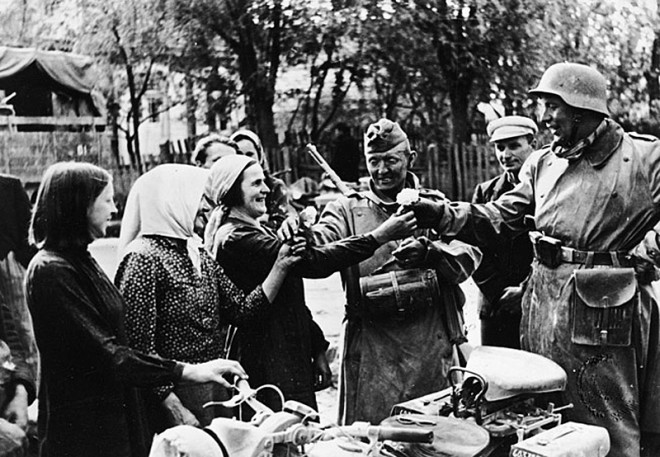
Every year in early February domestic and foreign far right groups celebrating the „breakthrough” of German and Hungarian forces on February 11, 1945 from the city of Budapest, which was surrounded by Soviet troops on all sides. In December 1944 two Soviet peace parliamentarians were killed when they were trying to convey an ultimatum.

The siege of Budapest lasted 64 days and was one of the bloodiest encounters of the war. Hitler forbade the German military to abandon the city or to try to escape before the total encirclement of Budapest took place. The fights went on from streets to streets and the frontline often changed.
Between December 24 and December 27 the Red Army managed to surround the Buda side of the city. The Soviets reached Pest in January and by January 17 they liberated the Pest ghetto. The siege of Buda started on January 20 and lasted until February 11.
So, this is the „Day of Honor” the Hungarian, German and Austrian neo-Nazis, as well as from other neighbouring countries (e.g. Ukraine, Slovakia, Romania, Serbia, etc.) remember every year in early February. According to their website the walking tour is organized „in remembrance of those Hungarian and German soldiers who in World War II heroically defended Budapest and Western Europe from the Bolshevik Red Army.”
As always, some of the Budapest anti-Fascist groups (about 150 people, mainly young ones holding red flags and a lot of them is a close ally of Attila Vajnai`s Workers Party of Hungary 2006) went out to protest against the „Day of Honor” on February 9. This year, the neofascists were banned to gather in the Buda Castle district, because since the beginning of this year it has been a new governmental area with Orbán`s office, similarly to the infamous Horthy time in the inter world war period. The neo-Nazi groups, with about 300 Hungarian and foreign participants claiming themselves as only „tradition-keepers” were holding their rally on Buda side in Városmajor near the rebaptized from Moscow Square to Széll Kálmán Square. They were dressed in black, in SS uniforms and with swastikas. The foreigneres were even ready to pay EUR 10/person (about HUF 3,200, while the Hungarians HUF 2,000) as a participation fee, and looked happy because they are banned to hold such neofascist demonstrations in their home country. This phenomenon is another brilliant example of the right wing shift of the Hungarian political life. It is also an alarming and dangerous development in Hungary that the ruling Fidesz encourages to produce falsified accounts of our history from a far right perspective. On top of that it is sad to see that neither of the parliamentary opposition parties supported the antifascist demonstrations.
The most significant negative development, however is that the opposition parties are accepting the previously hard-core far-right Jobbik party as „their partner” while Attila Vajnai`s party being a Communist is excluded from the anti-Orbán coalition.
The 18th State of Nation Address of PM Viktor Orbán was given at Várkert Bazár (at the foot of the Castle Area) on Buda side on February 10. It was the first time that the venue was hermetically closed for the public, it was surrounded by heavy blocks of concrete, covered by black canvas. The audience of Orbán`s State of Nation Speech was transported there by big buses. An all-opposition demonstration was organized with about 1,000 people against Orbán`s dictatorship in front of János Áder`s, State President`s Office in the Castle.
Well in advance of Orbán`s speech it was clear that a new political situation is emerging in Hungary before the oncoming EUP elections. It was not a surprise that Orbán had ramped up his populist rhetoric claiming that Hungary is the last resort to fight against the „islamization” of Europe. Orbán called the Hungarian opposition as „a bunch of pro-immigration politicians who are kept on a respirator by George Soros and the EU bureaucrats”. His rhetoric might strengthen the hand of those calling for Orbán’s right wing populist party Fidesz to be ousted from the European People’s party.
These are the antecedents of Mike Pompeo`s visit to Budapest on February 11. Orbán`s illiberal rule will be the focus of the discussions. U.S. diplomacy toward Hungary is entering a new phase as Washington strengthens its efforts to counter Russia’s and China’s growing influence over central Europe. Pompeo is seemingly concerned about democracy, but his real aim is to bolster security relationships with Hungary and to conclude deals of defense cooperation (i.e. selling US air-defense missiles to the region).
Pompeo is scheduled to meet with Hungarian civil society leaders before seeing local officials and will also announce a new program to support independent media in central Europe. Orbán has tightened his grip on civil society organizations, news outlets and academia to create a state modeled on the likes of Russia and Turkey.
Budapest, 11 February 2019.
Matyas Benyik and György Droppa
Megosztás a facebookon